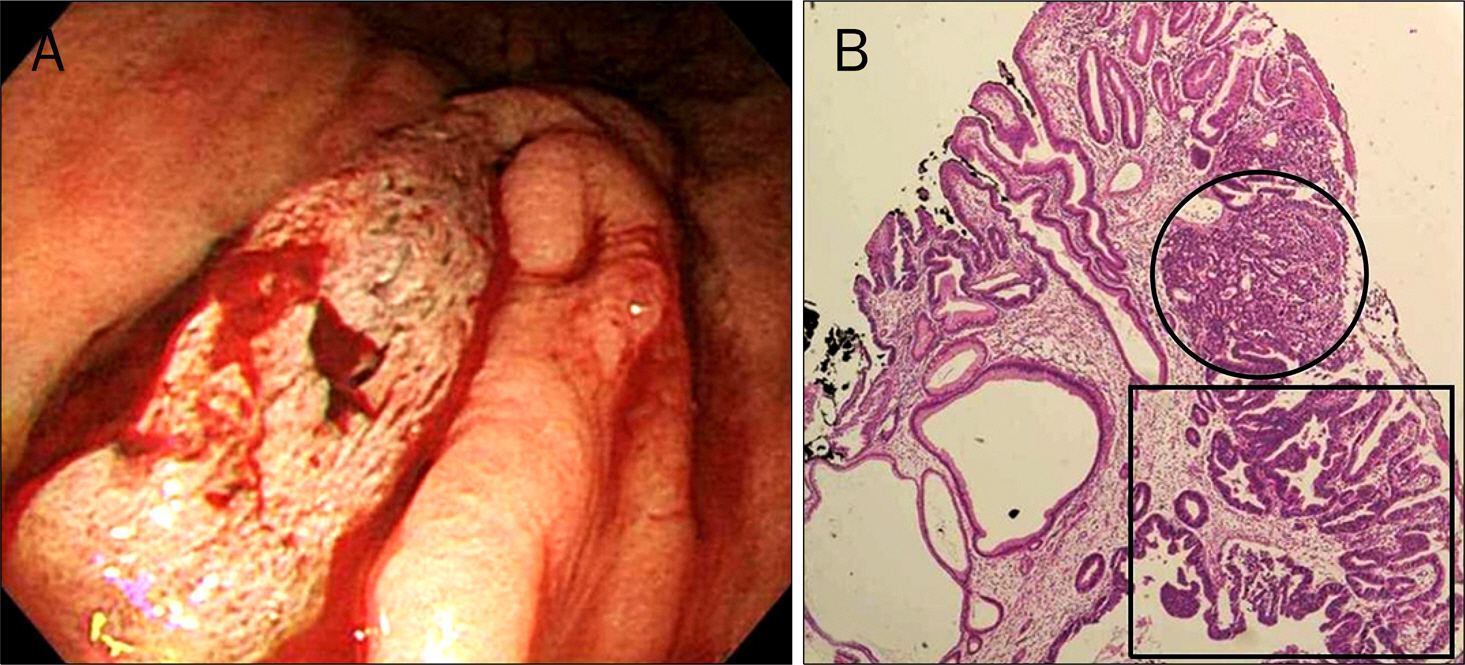Korean J Gastroenterol.
2011 Oct;58(4):184-189. 10.4166/kjg.2011.58.4.184.
Clinical Factors Predicting for Neoplastic Transformation of Gastric Hyperplastic Polyps
- Affiliations
-
- 1Department of Internal Medicine, Sanggye Paik Hospital, Inje University College of Medicine, Seoul, Korea. osbbang@paik.ac.kr
- 2Department of Pathology, Sanggye Paik Hospital, Inje University College of Medicine, Seoul, Korea.
- KMID: 1718426
- DOI: http://doi.org/10.4166/kjg.2011.58.4.184
Abstract
- BACKGROUND/AIMS
Hyperplastic polyps (HPs) are the most common cause of all benign epithelial gastric polyps, constituting 30 to 93%. Although gastric HPs are usually considered as benign lesions compared with adenoma, neoplastic transformation has been known to occur rarely. We aimed to identify the clinical factors of gastric HPs predicting for neoplastic transformation.
METHODS
Between January 2002 to August 2010, a total of 274 gastric HPs, which had been removed by endoscopic polypectomy or surgical resection from 210 patients, were analyzed retrospectively.
RESULTS
Neoplastic transformation was found in 15 cases (5.5%) of 274 HPs including 10 cases of low grade dysplasia (3.7%), 2 cases of high grade dysplasia (0.7%) and 3 cases of adenocarcinoma (1.1%). Neoplastic transformations were significantly associated with >1 cm in size (n=10 [66.7%] vs. n=91 [35.1%], p=0.024), with pedunculated shape (n=9 [60.0%] vs. n=62 [23.9%], p=0.002), with previous history of gastrectomy (n=3 [20.0%] vs. n=3 [1.2%], p=0.002) and with synchronous neoplastic lesions occurring elsewhere in the gastric mucosa (n=5 [33.3%] vs. n=31 [12.0%], p=0.021). However, no significant difference was found between HPs with and without neoplastic transformation in terms of age, sex, number of polyps detected per patient, location, macroscopic appearance such as erosion, hyperemia.
CONCLUSIONS
Neoplastic transformation of gastric HPs had significant relationships with >1 cm in size, pedunculated shape, postgastectomy state, and synchronous neoplastic lesion. Therefore, endoscopic polypectomy should be considered in these HPs to avoid the risk of missing HPs with neoplastic potential.
Keyword
MeSH Terms
Figure
Cited by 3 articles
-
Gastroduodenal Intussusception Resulting from Large Hyperplastic Polyp
Dong Jin Kim, Jun Hyun Lee, Wook Kim
J Gastric Cancer. 2012;12(3):201-204. doi: 10.5230/jgc.2012.12.3.201.Adenocarcinoma Occurring in a Gastric Hyperplastic Polyp Treated with Endoscopic Submucosal Dissection
Hye Won Jang, Hyun Yong Jeong, Seok Hyun Kim, Sun Hyung Kang, Jae Kyu Seong, Kyu Sang Song, Hee Seok Moon
J Gastric Cancer. 2013;13(2):117-120. doi: 10.5230/jgc.2013.13.2.117.Gastric Polyps and Protruding Type Gastric Cancer
Jin Tae Jung
Clin Endosc. 2013;46(3):243-247. doi: 10.5946/ce.2013.46.3.243.
Reference
-
References
1. Ming SC, Goldman H. Pathology of the gastrointestinal tract. 1st ed.Philadelphia: WB Saunders;1992.2. Deyhle P. Results of endoscopic polypectomy in the gastrointestinal tract. Endoscopy. 1980; (Suppl):35–46.3. Carmack SW, Genta RM, Schuler CM, Saboorian MH. The current spectrum of gastric polyps: a 1-year national study of over 120,000 patients. Am J Gastroenterol. 2009; 104:1524–1532.
Article4. Jain R, Chetty R. Gastric hyperplastic polyps: a review. Dig Dis Sci. 2009; 54:1839–146.
Article5. Hattori T. Morphological range of hyperplastic polyps and carcinomas arising in hyperplastic polyps of the stomach. J Clin Pathol. 1985; 38:622–630.
Article6. Goddard AF, Badreldin R, Pritchard DM, Walker MM, Warren B. British Society of Gastroenterology. The management of gastric polyps. Gut. 2010; 59:1270–1276.
Article7. Deppisch LM, Rona VT. Gastric epithelial polyps. A 10-year study. J Clin Gastroenterol. 1989; 11:110–115.8. Muehldorfer SM, Stolte M, Martus P, Hahn EG, Ell C. Multicenter Study Group "Gastric Polyps". Diagnostic accuracy of forceps biopsy versus polypectomy for gastric polyps: a prospective multicentre study. Gut. 2002; 50:465–470.
Article9. Han AR, Sung CO, Kim KM, et al. The clinicopathological features of gastric hyperplastic polyps with neoplastic transformations: a suggestion of indication for endoscopic polypectomy. Gut Liver. 2009; 3:271–275.
Article10. Abraham SC, Singh VK, Yardley JH, Wu TT. Hyperplastic polyps of the stomach: associations with histologic patterns of gastritis and gastric atrophy. Am J Surg Pathol. 2001; 25:500–507.
Article11. Krejs GJ. Gastric cancer: epidemiology and risk factors. Dig Dis. 2010; 28:600–603.
Article12. Dirschmid K, Platz-Baudin C, Stolte M. Why is the hyperplastic polyp a marker for the precancerous condition of the gastric mucosa? Virchows Arch. 2006; 448:80–84.
Article13. Orlowska J, Jarosz D, Pachlewski J, Butruk E. Malignant transformation of benign epithelial gastric polyps. Am J Gastroenterol. 1995; 90:2152–2159.14. Nakamura T. Malignant change of gastric polyp, with special reference to histopathological classification. Stomach Intestine. 1968; 3:737–747.15. Daibo M, Itabashi M, Hirota T. Malignant transformation of gastric hyperplastic polyps. Am J Gastroenterol. 1987; 82:1016–1025.16. Hizawa K, Fuchigami T, Iida M, et al. Possible neoplastic transformation within gastric hyperplastic polyp. Application of endoscopic polypectomy. Surg Endosc. 1995; 9:714–718.
Article17. Rosen S, Hoak D. Intramucosal carcinoma developing in a hyperplastic gastric polyp. Gastrointest Endosc. 1993; 39:830–833.
Article18. Orlowska J, Pietrow D. Multifocal gastric carcinoma arising from hyperplastic and adenomatous polyps. Am J Gastroenterol. 1990; 85:1629–1634.19. Zea-Iriarte WL, Sekine I, Itsuno M, et al. Carcinoma in gastric hyperplastic polyps. A phenotypic study. Dig Dis Sci. 1996; 41:377–386.
- Full Text Links
- Actions
-
Cited
- CITED
-
- Close
- Share
- Similar articles
-
- Clinical Factors for Consideration in Patients with Gastric Hyperplastic Polyps Treated by Endoscopic Polypectomy
- The Clinicopathological Features of Gastric Hyperplastic Polyps with Neoplastic Transformations: A Suggestion of Indication for Endoscopic Polypectomy
- A Case of a Gastric Hyperplastic Polyp with a Signet Ring Cell Carcinoma
- A Case of Adenocarcinoma Arising in Hyperplastic Polyp in the Stomach
- Two Cases of Adenocarcinoma Arising from Gastric Hyperplastic Polyp



